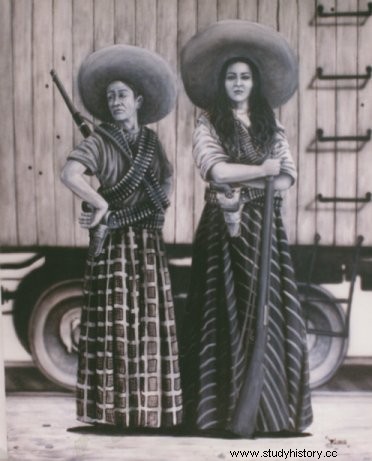Mexican revolutionary, Petra Herrera (1887 –?) first participated in the Mexican Revolution under a male identity before creating his own female brigade.
The Mexican Revolution

Petra Herrera was born on June 29, 1887, in an independent Mexico since the beginning of the century but destabilized by the conflicts following independence and subjected, since 1876, to the authoritarian regime of President Porfirio Díaz. Corruption, racism, inequalities, repression reign supreme there. Indigenous communities, peasants and workers are particularly exposed to exploitation, misery and violence. Women, on the other hand, have no civil or political rights and live under the domination of the men of their family. Voices were raised in all classes of society to oppose Díaz, but the first revolts were violently repressed.
At the beginning of the 20th century, political, economic and environmental factors exacerbated tensions:an agrarian policy carried out for the benefit of large landowners and favoring the concentration of land (95% of peasants then owned no land), the financial crisis of 1907 which caused a general drop in income, the droughts of 1908 and 1909 which forced the import of corn, the increase in taxes… Opposition newspapers were born, strikes and demonstrations broke out. In 1907, those of the textile industry in the east of the country ended with a massacre that killed nearly 200 people in Veracruz.
In 1908, Díaz asserted, in an interview for the American public, that he had no intention of running for the 1910 elections and accepted the creation of opposition parties. The following year, several political parties were born, with other candidates for the presidential elections, including that of Francisco Madero. In 1910, Díaz presented himself despite everything, with Madero as his opponent. The government accuses the latter of mounting public opinion against the president. Madero was arrested and then, released on bail after the victory was declared largely in favor of Díaz, fled to Texas. From there, he contested the election results and launched a call for insurrection on November 20 with, in his program, a commitment to return land. The revolution gained momentum in 1911, under the command of insurgents such as Emiliano Zapata or Pancho Villa.
Soldadera
This is where Petra – or rather Pedro – Herrera comes into the picture. Of its existence before the Mexican Revolution, we know almost nothing. Originally from the north of the country, she is probably a peasant of indigenous origin, or mestiza – indigenous and European. And whether it's out of political opposition to Díaz, hope that Madero will fulfill her promises of land redistribution, or a desire to invent her own destiny, she has every intention of participating in the revolution. Refusing the domains assigned to women – care or supplies – she cut her hair, put on men's clothes, concealed her chest and joined General Pancho Villa's troops under the name of Pedro Herrera.
Quickly, Petra stands out for her courage, her marksmanship, her expertise with explosives to blow up bridges and above all her command abilities. She carefully tries to conceal her identity as a woman, dutifully shaving every morning in plain sight, but the lie ends up weighing her down. Reaching the head of 200 men, believing that she has proven herself, Petra says:"I am a woman and I will continue to serve as a soldier" . But the army, which praised Pedro's command abilities, refuses Petra any military rank.
A female battalion
Excluded from the army, Petra Herrera forms a battalion of 400 soldaderas , female soldiers. At the head of this troop, she took part in the second battle of Torreón in May 1914 and played a crucial role there. A companion of Pancho Villa, Cosme Mendoza Chavira, said:"Ella fue quien tomo Torreón y apago las luces cuando entraron en la ciudad" (It was she who took Torreón and who turned off the lights when entering the city). A revolutionary song dedicated to Petra Herrera the "courageous" recounts the feat, but Pancho Villa will not recognize its merits either.
However, the soldadera remains as determined as on the first day to fight for the revolution. At the head of a non-mixed battalion of combatants, she continues the fight. The security of his troops is important to him and the camp is forbidden to men, the sentries having the instruction to shoot at any intruder. Their participation in the revolution is not self-evident, far from it; many revolutionaries, including Pancho Villa, regard them with disdain, even hostility. Alvaro Obregon will definitely use soldaderas as a human shield for his troops.
In 1917, Petra Herrera allied with a revolutionary general more favorable to the participation of women in the revolution, Venustiano Carranza. Elected President of the Republic, the latter instituted a pension for the widows of his soldiers and granted Petra the rank of colonel. As the fighting lessens in intensity, her female battalion is disbanded. Petra's life at the end of the revolution is as mysterious as the years preceding it:depending on the version, she was a spy and waitress in a bar, she was assassinated by counter-revolutionaries or formed a brigade of 25 000 women. Like other soldaderas , its role in the revolution is obscured and it falls into oblivion.
